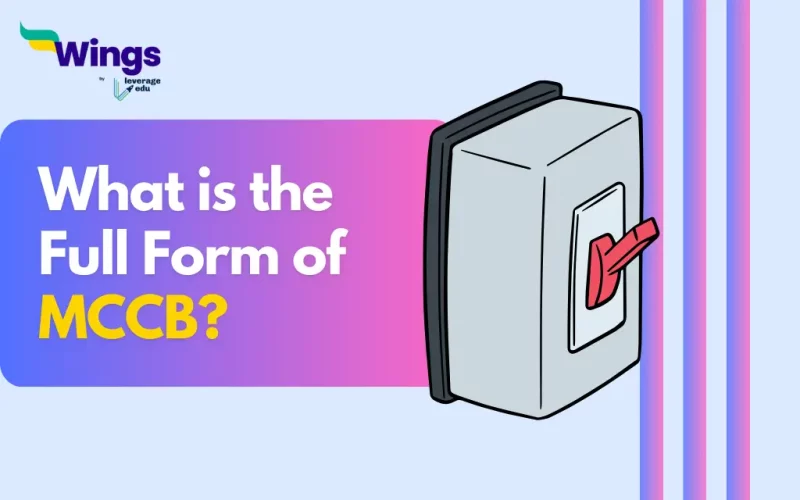The Full Form of MCCB in Electrical is a Moulded Case Circuit Breaker. It is described as a circuit breaker in construction. Moreover, the circuit breaker has an important part in the unit assembly, hence supporting the insulating material sector. Read on to learn more about MCCB Full Form in Electrical, its types, functions and its advantages and disadvantages.
Table of Contents
What is an MCCB?
MCCB is a circuit-closing and circuit-opening device that can be operated manually or automatically in response to a significant overcurrent without causing damage to itself. Additionally, MCCB is also the advanced version of MCB which is the miniature service breaker. Moreover, MCCB is available in the range from 32 Amps to 1600 Amps, with a voltage of 230 volts to 1.1 kilovolts.
In addition, there are nine parts of an MCCB, which are as follows:
- Moving Contact
- Arc chute
- Operating mechanism
- Terminal Connector
- Base cover
- Handle knob
- Overload trip or Bimetallic contact
- Manual trip button
- Current Transformer assembly
Also Read: What is the full form of AOP?
What are the Types of MCCB?
Moreover, the Types of MCCB are listed in the table below:
| TYPES OF MCCBS | |||
| Types | Trips | Uses | Application |
| Type A | 2.3 times | Highly sensitive Semiconductor | Domestic Purposes |
| Type B | 3-5 times | Low inrush load, in making computer equipment which has a low surge current level | Industrial and Domestic Purposes |
| Type C | 5-10 times | Low inrush loads protect the inductive load. It is used in fluorescent lights, pilot devices, control devices, and coils. | Small-scale industrial and commercial purposes |
| Type D | 10-20 times | High inrush current flow, such as X-ray machines, high voltage winding machines, etc. | Commercial, specialist domains |
| Type K | 8-12 times | High inrush current and is suitable for motor applications, transformers, auxiliary circuits, etc. | Industrial Area |
| Type Z | 2-3 times | Protects from the long duration of currents | Industrial Area |
Also Read: What is the full form of MPSC?
What are the Functions of an MCCB?
Furthermore, the Functions of an MCCB are as follows:
- Thermal Overload: MCCB prevents thermal overload by using equipment that is sensitive to temperature. Moreover, when heat builds up between the insulation and the conductor, this condition happens.
- Short Circuit: The solenoid coil in MCCBs is based on electromagnetic principles and operates in short circuits.
- When the short circuit occurred, a large amount of current began to flow through the solenoid.
- Thereby producing a powerful electromagnetic field that attracted the trip bar and ultimately opened the current contract.
- Earth Fault Protection: In an emergency, MCCB’s internal arc dissipation procedures help in disconnecting switches. In addition, it can be utilized in an electric switch so that the current flow can be manually cut off by pulling the MCCB arc.
Also Read: What is the Full Form of MPCB?
What are the Advantages of MCCB?
Here are the Advantages of MCCB:
- MCCB has an adjustable trip that can be used for low and large amounts of current.
- Moreover, it can handle a large amount of current.
- A movable MCCB can stop large power flows.
- MCCB offers remote switches, where it has on/off features, which can be done manually.
What are the Disadvantages of MCCB?
Here are the Disadvantages of an MCCB:
- A confined and limited application to domestic and special areas.
- It cannot be used in high-voltage industrial areas.
Popular Full Forms
FAQs
The main components of an MCCB include the arc chute, moving contact, operating mechanism, terminal connector, overload trip, handle knob, manual trip button, and current transformer assembly. These components work together to detect overcurrent conditions, interrupt the circuit, and provide protection against thermal overload, short circuits, and earth faults.
MCCBs are available in various types, such as Type A, B, C, D, K, and Z, each designed to cater to specific applications and current trip characteristics. Type A to Z MCCBs differ in their sensitivity to overcurrent conditions, trips, and applications, ranging from domestic purposes to industrial areas, based on the type of load and protection requirements.
Advantages of MCCBs include their adjustable trip settings, ability to handle large currents, suitability for various applications, and provision of remote switching capabilities. However, disadvantages include limited applications in high-voltage industrial areas and potential constraints in domestic and specialized applications.
We hope this blog has helped you understand the MCCB Full Form and everything related to it. If you want to know more, find the full forms list on our blog. In the world of short forms, you can rely on the Leverage edu page to know about more full forms like this! Connect with us study abroad experts to achieve your international dream today!
 One app for all your study abroad needs
One app for all your study abroad needs













